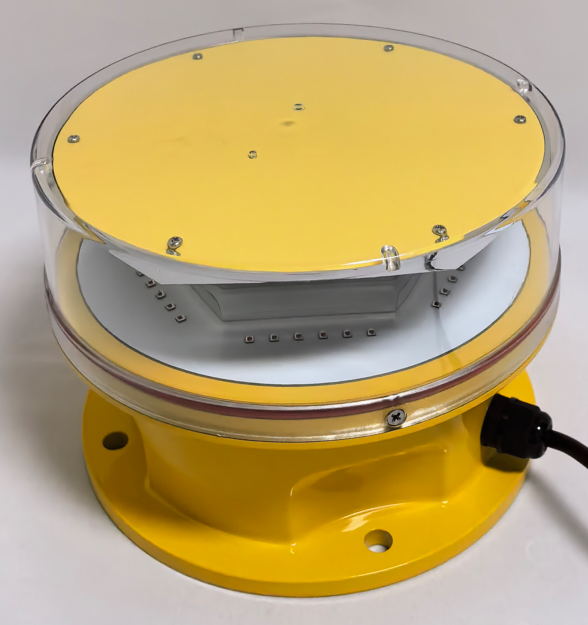The Sentinel's Glow: Unraveling the Critical Role of Red Obstruction Light
In the vast and intricate tapestry of aviation safety, few visual signals are as universally recognized and critically important as the steady or flashing glow of a red obstruction light. These unassuming yet vital sentinels stand watch atop countless structures worldwide, from skyscrapers to wind turbines, providing the first line of defense against aerial collisions. This article examines the technical specifications, regulatory framework, and evolving technology behind these essential safety devices that form the backbone of aerial obstruction marking systems.
The Universal Language of Caution
The red obstruction light serves as an international visual language that communicates immediate danger to pilots. Unlike white strobes used primarily during daylight hours, the red light's specific wavelength offers distinct advantages for nighttime visibility. Its unique spectral characteristics allow it to penetrate atmospheric haze and light pollution more effectively than other colors, making it particularly valuable in urban environments and adverse weather conditions. This specific chromatic choice represents decades of aviation research into human visual perception and operational safety requirements.
Regulatory Precision and Application Standards
The deployment of red obstruction light systems follows meticulously defined international standards established by organizations including the International Civil Aviation Organization (ICAO) and Federal Aviation Administration (FAA). These regulations specify:
Intensity Requirements: Precise candela ratings based on structure height and location relative to airports and flight paths

Placement Specifications: Mandatory positioning patterns that ensure 360-degree visibility from all approach angles
Flash Characteristics: Standardized flash sequences that distinguish obstruction lights from other aerial navigation lights
| red obstruction light |
Performance Standards: Rigorous testing protocols for weather resistance, durability, and operational reliability
Medium-intensity red obstruction light systems typically serve as the standard solution for structures between 150 and 500 feet in height, often complemented by white strobes for daytime enhancement.
Engineering Excellence in Hostile Environments
The effectiveness of a red obstruction light depends on its ability to maintain operational integrity under extreme conditions. Manufacturers address these challenges through:
Advanced Optical Systems: Precision-engineered lenses and reflectors that maximize light output while minimizing energy consumption. Modern systems utilize computer-optimized optics to achieve perfect beam distribution patterns that meet regulatory requirements without light pollution.
Environmental Hardening: Comprehensive protection against temperature extremes (-40°C to +55°C), humidity, UV radiation, and chemical exposure. Industrial-grade materials including marine-grade aluminum and polycarbonate composites ensure decades of reliable service.
Maintenance Optimization: Modular designs featuring quick-disconnect components and tool-less access panels significantly reduce service time and maintenance complexity. These features prove particularly valuable for offshore installations and remote locations where technician access involves substantial logistical challenges.
The LED Revolution in Reliability
The transition to LED technology has transformed red obstruction light performance standards. Contemporary systems leverage solid-state illumination to achieve:
Extended Operational Lifespan: 100,000+ hours of continuous operation without significant lumen depreciation
Enhanced Energy Efficiency: 60-70% reduction in power consumption compared to traditional incandescent systems
Instantaneous Performance: Immediate full-intensity illumination without warm-up periods, critical for emergency backup scenarios
Vibration Resistance: Superior tolerance to structural movement and wind-induced oscillation
These technological advancements have significantly reduced the total cost of ownership while dramatically improving system reliability and maintenance intervals.
Smart Systems and Future Integration
Modern red obstruction light installations increasingly incorporate intelligent monitoring and control capabilities. Advanced systems now feature:
Remote Diagnostics: Continuous performance monitoring with automated alert generation for proactive maintenance
Condition-Based Activation: Photocell and timer systems that automatically adjust operation based on ambient light conditions
Network Integration: Compatibility with building management systems and aviation authority monitoring networks
Redundancy Systems: Automatic failover to backup power and secondary light units during primary system failure
These smart capabilities transform simple warning devices into comprehensive safety systems that actively contribute to airspace management efficiency.
The Unseen Guardian of Urban Skies
The strategic importance of red obstruction light systems extends far beyond regulatory compliance. These installations form an invisible safety network that protects:
Urban Air Mobility: Enabling safe operation of emergency medical services, law enforcement, and news helicopters in congested airspace
Critical Infrastructure: Safeguarding communication towers, power transmission networks, and industrial facilities
Renewable Energy Projects: Permitting the safe expansion of wind energy installations both onshore and offshore
Architectural Development: Allowing continued vertical construction in growing urban centers without compromising aviation safety
As airspace becomes increasingly crowded with traditional aircraft, drones, and emerging urban air mobility vehicles, the role of the red obstruction light as a fundamental safety technology becomes ever more critical.
The red obstruction light represents a perfect convergence of regulatory wisdom, engineering excellence, and technological innovation. These devices stand as silent guardians of aerial navigation, providing continuous protection through day and night, in clear weather and storm. Their persistent red glow embodies the aviation industry's unwavering commitment to safety—a visual promise that the path ahead is clear and protected. As we advance toward increasingly complex aerial ecosystems, these fundamental safety systems will continue to form the bedrock upon which all other airspace safety measures are built.
